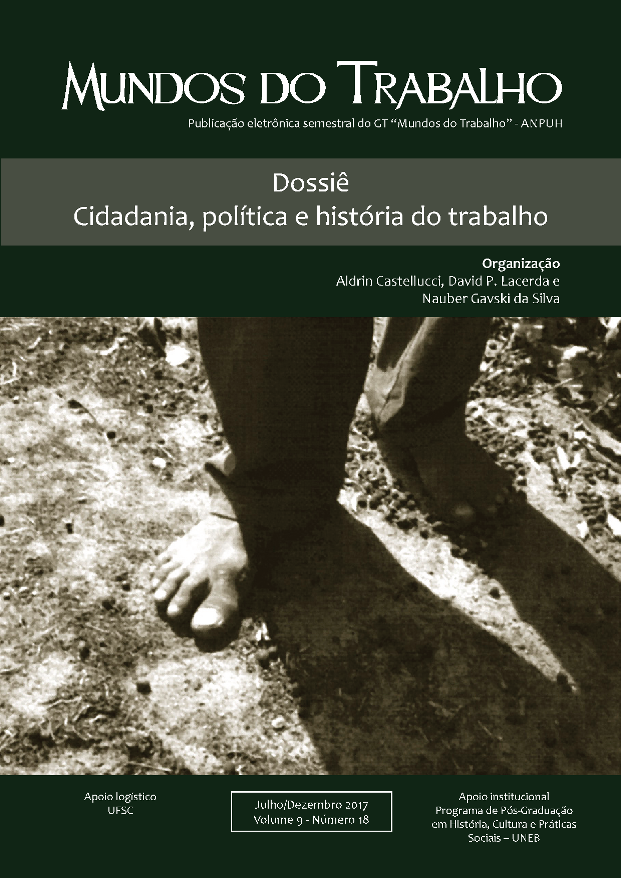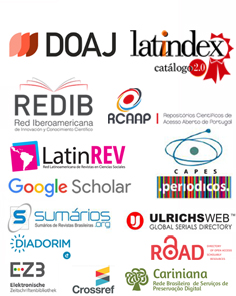Los k’ajchas* y los proyectos de industria y nación en Bolivia (1935-1940)
DOI:
https://doi.org/10.5007/1984-9222.2017v9n18p25Resumo
La Convención de 1938, realizada en la administración presidencial de los “Socialistas Militares”, fue expresión de la crisis política que desencadenó la Guerra del Chaco (1932-1935) anunciando las medidas que marcarían gran parte del siglo XX (el mayor rol del estado en la economía, la distribución de la tierra, las políticas hacia los recursos naturales, la ciudadanía de indígenas y de mujeres). Uno de los puntos considerados es si se arrendaban las minas abandonadas del cerro de Potosí a los llamados k’ajchas ¿Quiénes eran? ¿Eran pequeños propietarios y patrones? ¿Eran obreros proletarios o eran primitivos mineros? ¿Había que favorecerlos cuando tenían sistemas obsoletos y atrasados de explotación o había que crear sistemas industriales en “manos de la nación”? El trabajo reconstruye, en base a los periódicos de la época y a los redactores de la Convención, la situación de los k’ajchas en el período de crisis económica del estaño y de crisis política del país, analizando también las diversas interpretaciones y los diferentes proyectos que se plantearon en torno a la existencia de grandes empresarios como Mauricio Hothshild, en torno a los proletarios, y en torno a los pequeños mineros. Uno de los argumentos fundamentales que se plantea, es que la industrialización no fue posible pensarse en el contexto de la Convención a partir de los pequeños trabajadores, sino más bien, a través de la construcción de una industria en poder del Estado con sus propios obreros.Referências
ABSI, Pascale. “Q’aqchas y obreros: apuntes sobre la organización del trabajo minero”. Anuario Estudios Bolivianos Archivísticos y Bibliográicos, 2014.
ABSI, Pascale. Los ministros del Diablo. El trabajo y sus representaciones en las minas de Potosí. La Paz: IRD, Instituto de Investigación para el Desarrollo; Embajada de Francia en Bolivia; IFEA, Instituto Francés de Estudios Andinos; Fundación PIEB, 2005.
ALMARAZ, Sergio. El Poder y la caída. El estaño en la historia de Bolivia. Cochabam/6ba-La Paz: Los Amigos del Libro, 1967.
ALURRALDE ANAYA, Antonio. Cooperativas Mineras en Bolivia. La Paz: Don Bosco, 1973.
AYUB, Mahmood Ali; HASHIMOTO, Hideo. The Economics of Tin Mining in Bolivia. A World Bank Publication. Washington, D.C., 1985.
BALDIVIESO, Valentín Abecia. Historia del Parlamento, T. III. Bolivia: Congreso Nacional, 1997.
BARRAGÁN, Rossana. “¿Ladrones, pequeños empresarios o trabajadores independientes? K’ajchas, trapiches y plata en el cerro de Potosí en el siglo XVIII”. Nuevo Mundo Mundos Nuevos, 2015.
BARRAGÁN, Rossana. “K’ajchas, trapiches y plata en el cero de Potosí en el período colonial”. Anuario. Estudios Bolivianos, Archivísticos y Bibliográicos. 20, 2014, 273-320.
BARRAGÁN, Rossana. “Working Silver for the World: Mining Labor and Popular Economy in Colonial Potosi”. Hispanic American Historical Review, 97, May 2017, 193-222.
BIEBER, León. Dr. Moritz (Mauricio) Hochschild: empresario minero, promotor e impulsor de la inmigración judía a Bolivia. Santa Cruz de La Sierra: Editorial El País, 2015.
CONTRERAS, Manuel E. The Bolivian Tin Mining Industry in the First Half of the Twentieth Century. University of London. Institute of Latin American Studies. Research Papers 32, 1993.
DRINOT, Paulo. La seducción de la clase obrera. Trabajadores, raza y la formación del Estado peruano. Lima: Instituto de Estudios Peruanos y Ministerio de Cultura, 2016.
FRERKING, Oscar. “Las claúsulas económicos sociales en la Constitución política de Bolivia”. Las claúsulas económico-sociales en las constituciones de América, 2 vols. Buenos Aires. 1947-1948.
GEDDES, Charles. Patiño: Rey del Estaño. AG Grupo SA: Madrid, 1984.
GOTKOWITZ, Laura. La revolución antes de la Revolución. Luchas indígenas por tierra y justicia en Bolivia, 1880-1952. Plural: La Paz, 2011.
GOTKOWITZ, Laura. A Revolution for Our Rights: Indigenous Struggles for Land and Justice in Bolivia, 1880-1952. Durham: Duke University Press, 2007.
KLEIN, Herbert. Orígenes de la revolución nacional boliviana: La crisis de la generación del Chaco. La Paz: Librería Juventud, 1968.
PLATT, Tristan. “Producción, tecnología y trabajo en la Rivera de Potosí durante la República temprana”. In: BARRAGÁN, Rossana, QAYUM, Seemin y SOUX, María Luisa (Org.). El siglo XIX: Bolivia y América Latina. Travaux de l’IFEA 102: La Paz, 1997.
QUEREJAZU, Roberto. Llallagua, historia de una montaña. Editorial Los Amigos del Libro: Cochabamba-La Paz, 1977.
SCHELCHKOV, Andrey. “Antes de la Convención: la búsqueda de un nuevo modelo estatal – el experimento militar-socialista”. (Inédito).
STEFANONI, Pablo. “Los inconformistas del Centenario Intelectuales, socialismo y nación en una Bolivia en crisis (1925-1939)”. (Tesis de Doctorado, Facultad de Filosofía y Letras, Universidad de Buenos Aires 2014).
STEFANONI, Pablo; SCHELCHKOV, Andrey (Coords.). Historia de las izquierdas bolivianas. Archivos y documentos (1920-1940). CIS: La Paz, 2016.
TENORIO, Carlos. “Orígenes de las irmas del industrial minero. Mauricio Hochschild Hirsch en Bolivia: crecimiento económico en Potosí (1921-1939)”. (Tesis de Licenciatura de Historia, UMSA, 2011).
WASZKIS, Helmut. “Moritz Hochschild: a German Jewish Mining Entrepreneur and his Companies in South America, 1911-1965”. (Ph.D. Dissertation, Freie Universitaet, Berlin, 2000).
Downloads
Publicado
Como Citar
Edição
Seção
Licença
Os autores cedem à Revista Mundos do Trabalho os direitos exclusivos de primeira publicação, com o trabalho simultaneamente licenciado sob a Licença Creative Commons Attribution (CC BY) 4.0 International. Esta licença permite que terceiros remixem, adaptem e criem a partir do trabalho publicado, atribuindo o devido crédito de autoria e publicação inicial neste periódico. Os autores têm autorização para assumir contratos adicionais separadamente, para distribuição não exclusiva da versão do trabalho publicada neste periódico (ex.: publicar em repositório institucional, em site pessoal, publicar uma tradução, ou como capítulo de livro), com reconhecimento de autoria e publicação inicial neste periódico.









